Changes to the amount of money miners pay to dig up precious metals in Western Australia have been floated at government crisis talks as the nickel industry bears the brunt of a global price decline.
Key points:
- The price of nickel is in a rut
- In WA, mines have closed and workers have been laid off
- The government is considering charging companies less to mine
A glut in the international market – sparked in part by robust supply from Indonesia, the Philippines and China – has seen nickel plummet 43 per cent over the past year.
These past weeks have seen Andrew Forrest’s Wyloo Metals reveal it would mothball its Goldfields nickel mines while Panoramic Resources will close the Savannah nickel mine in the Kimberley, shedding hundreds of jobs.
Lithium prices have also plunged 80 per cent in the past year sparking fears for the future of these “strategic” metals – seen as critical in the country’s renewable energy transition.
Federal resources minister Madeline King and WA mines minister David Michael met with nickel and lithium industry heavyweights today, pledging state and federal level support.
ABC News: Rebecca Trigger
)
Mr Michael said reforms to WA’s royalty scheme based on price, on a sliding scale, were put forward and he would take them to government.
It means nickel miners could pay less to operate in WA.
“It’s something that I’ve committed at least to investigating with the sector,” he said.
“Royalty reform which will go on for a very long time is something that would affect the government and the mining sector for many years.”
Royalty rates court controversy
Currently WA levies 2.5 per cent on nickel sales, generating $128 million in 2022.
In WA, one of three royalty rates (2.5 per cent, 5 per cent and 7 per cent) are applied depending on the form of the mineral when it is sold and how much it is processed.
Attempts to change the system in 2017 sparked a war with gold miners after the government sought to raise their payments.
A Nationals WA policy to increase fees iron ore miners pay to the government also saw the political demise of their leader Brendon Grylls in 2016.
That plan would have taken a 25 cent per tonne production rental fee set for BHP Billiton and Rio Tinto in the 1960s, and increase it to $5 a tonne, raising billions of dollars of extra revenue for the state.
When asked whether he thought iron ore or gold producers would be open to longer-term reform, the mines minister conceded he wasn’t sure.
“It depends what the reform looks like,” Mr Michael said.
“At the moment I’m focused on nickel given they’re the ones with some pending issues due to the oversupply of nickel across the globe.”
Mr Michael also flagged short-term relief could be on the cards in the form of royalty payment deferrals but could not provide details on what would trigger repayments.
“In terms of relief, I’m hoping to get some options at least for government to look at and to look at what impact they would make [for] those mining operations that currently are teetering on the price point,” he said.
Ms King said she would also take a proposed production tax credit – designed to encourage processing of minerals onshore — to treasury to be costed.
Loading…
Global mining players including BHP were present at the meeting.
BHP’s Nickel West asset president Jessica Farrell said it was critical Australia remained globally competitive in strategic minerals.
“I think we have a real crisis, and in terms of working on that in Australia we need speed,” she said.
Lithium also in crisis
Nickel is mainly used to make stainless steel but its use in electric vehicles is growing.
Western Australia produces five per cent of global supply.
The cost of production is high but the state also produces one of the purest grades of the metal which is suitable for battery production.
Andrew Forrest’s Wyloo was represented by Luca Giacovazzi who declined to speak to media after the meeting.
The lithium industry, also due to meet with government today, has plunged 80 per cent in the past year.
Western Australia has a five per cent royalty rate on the value of lithium concentrate and it accounted for four per cent of WA’s total royalty revenue.
Lithium royalties in Western Australia rose from $60 million in 2021 to $457 million in 2022.
Do you know more about this story? Contact Rebecca Trigger.
Want more local WA news?
Select “Western Australia Top Stories” from either the ABC News homepage or the settings menu in the app.
Loading
